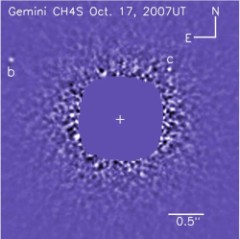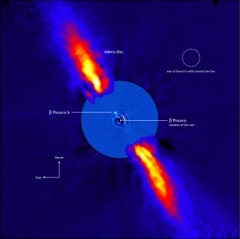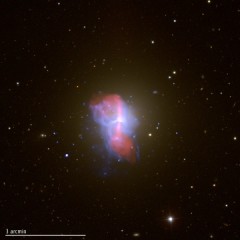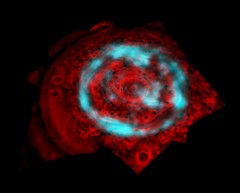We have, as always, some very exciting news for you from the wire and in this edition there is a certain theme, that of imaged exo-planets. There have been some amazing discoveries yielded by impressive research into the final frontier including the first visible light image taken of an extra-solar planet, the first image of a multi planet system and another imaging of an exo-planet that is at about the same distance from its star as Saturn is from ours, which is yet another first. As well a team of researchers have discovered that super-massive black holes act like a throbbing heart at the core of galaxies. As well we will take a look at some strange auroral properties on our gigantic neighbor Saturn.
First Visible Light Picture of an Extra-solar Planet:
A very exciting first has been achieved; with the help of the Hubble Space Telescope the first visible light image of a planet outside our solar system has been taken. The planet imaged is being called Fomalhaut b; it orbits the star Fomalhaut that lies in the southern constellation Piscis Australis, which is about 25 light years away from the Earth.  | Picture taken by the Hubble of Fomalhaut
b. Credit: NASA, ESA and Z. Levay(STScI) |
The system was imaged in 2004 producing a view of the star and the proto-planetary disc that surrounded it, which is a large disc of gas and dust that surrounds a newly forming star system. The disc itself is very large, some 21.5 billion miles from edge to edge with the planet occupying a position about 10.7 billion miles (about 10 times the distance of Saturn from the Sun) from its parent star, making its orbital period 872 years long. This is an impressive accomplishment of observational techniques and equipment, for the planet itself is a billion times fainter than the parent star, making the detection at the limits of observability. The planet itself could have formed in its current position or it could have formed much closer to its star and has migrated out to its current position in the system through gravitational interactions, but either way it is known to be at most three Jupiter masses. The star, Fomalhaut, is much larger than our own and therefore will have a much shorter lifespan, around a billion years, which is just a fraction of the life of our own star and because of the size difference Fomalhaut is also much brighter than the Sun. This discovery marks the beginning of what will surely be a future filled with exo-planet discovery. To read more on this exciting discovery please visit the following link: http://hubblesite.org/newscenter/archive/releases/2008/39/text/
The First Family of Extra-solar Planets:
Using the Gemini and Keck observatories a team of astronomers have obtained the first direct image of a family of exo-planets around the
 | Image of the multi-planet system.
Credit: Gemini Observatory |
star HR 8799 in the constellation Pegasus, revealing a system that very much resembles our own, only on a slightly larger scale. The star is a young one, more massive than our own, five times as bright, located around 130 light years from the Earth, and has a massive disc of gas and dust around it. The images were taken from ground based observatories using the some of the newest and most advanced adaptive optics technology, allowing the groundbreaking infra-red images. The planets themselves are relatively new, having formed only around sixty million years ago, maintaining enough heat that they are still glowing from formation and are found at distances from their parent star of 25, 40, and 70 times the distance of the Earth to the Sun, being about ten, ten and seven times the mass of Jupiter, respectively. The image marks another milestone for exo-planet investigation, not only is this the first image of a multi-planet system but it was taken from the ground, which is a remarkable achievement considering that only a few years ago such an image would have been a strict impossibility due to technological limitations. To read more on this and to see our original source follow this link: http://www.gemini.edu/node/11151
Planet around Beta Pictoris?:
Using the Very Large Telescope (VLT) a team of French astronomers have imaged an object
 | Picture of Beta-Pictoris.
Credit: ESO |
that appears to be a planet around the star Beta Pictoris. The star itself is one of the first to have had its proto-planetary disc imaged and is the most intently studied star system (other than our own of course). The star is located around 70 light years away from the Earth in the constellation Pictor and at only twelve million years old, Beta Pictoris is a young star though it is much larger, more massive and hotter than our own. The planet that has been possibly imaged is a giant one, having about eight times the mass of Jupiter but, if actual, is the closest exo-planet to its parent star ever imaged, having about the same distance from its star as Saturn does from the Sun. Through steady past observations of the system certain properties of the disc of gas and dust that surround it were observed that seemed to indicate, all be it indirectly, that there was an unseen planet lurking in the bright halo of the star and what is exciting is that the planetary candidate explains these observations very neatly. Though the team is holding out on declaring this point of light a planet once and for all, all the evidence so far heavily indicates that it is and indeed it would unexpected if it turned out to be merely a foreground or background object. This discovery is the result of years of hard work done by numerous teams of people with the most advanced observational equipment available, which goes to show the massive undertaking that locating exo-planets really is. To find out more about this (possible) discovery please visit the following link and our original source: http://www.eso.org/public/outreach/press-rel/pr-2008/pr-42-08.html
The Pulsing Heart of Galaxies:
 | Picture of M84 taken in X-ray by Chandra.
Credit: (Credit: X-ray (NASA/CXC/MPE/
A.Finoguenov et al.); Radio (NSF/NRAO/
VLA/ESO/R.A.Laing et al); Optical (SDSS)) |
Using the Chandra X-Ray Observatory an impressive team of scientists have discovered that black holes have a steady function in the “heart” of their host galaxies. It has been known for some time that the central black hole of galaxies produce violent and massive outbursts that throw material huge distances across space, but now observations and modeling of the black hole in the galaxy M84 have shown that these monsters also produce a calmer, more “rhythmic” energy, pumping hot gas into their home galaxies. One of the scientists working on the project, Alexis Finoguenov, has made a comparison of these super-massive black holes, in light of this new information, to a heart muscle for the galaxy, saying “Just like our hearts periodically pump our circulatory systems to keep us alive, black holes give galaxies a vital warm component.” The idea being that this throbbing source of warmth stabilizes star production in galaxies, because gas needs to be cool to condense and form stars. Observations of the black hole in M84 appear to show that the throbbing energy output occurs at a regular rate pulsing energy into the surrounding environment, stabilizing the system and extending the ‘life’ of the galaxy. This discovery also helps to explain some observations made by the Chandra X-Ray observatory of hot gas surrounding some galaxies, that until now had remained mysterious to astronomers. Not only does the heat from the pulsating “heart” slow the formation of stars in the surrounding environment, it is believed to slow the growth of the black hole itself keeping the galaxy at a greater stability. Black holes have been the object of curiosity since their discovery and have held many a person captivated by their strangeness, and even though it has been known for some time that these objects exist, their overall function in their environment is just now beginning to come to light, the more we learn about them, the more we see that they aren’t just some monstrous creation of nature that threaten doom and gloom, but rather they are an intricate part of the universe, one that fulfills a vital and necessary role in the cosmos. To read more on this story please visit the following link and our original source: http://www.ns.umich.edu/htdocs/releases/story.php?id=6837
Strange Saturnian Lights:
Using data from the Cassini craft, which is investigating the Saturnian system, some mysterious properties of Saturn’s aurora have come to
 | The strange aurora on Saturn.
Credit: NASA/JPL/University of Arizona |
light. Saturn has been known to have an aurora for some time and it has been observed numerous times, both by Cassini and the Hubble space telescope but the most recent data has shown that the northern aurora has properties that make it different from any other aurora known. Auroras usually fit into two categories, those that are influenced most predominantly by the solar wind, as Earth’s is, and those that are more dominated by internal processes of the planet itself, as in the case of Jupiter’s, but the observed aurora on Saturn falls into neither of these categories. There are several odd properties of Saturn observed at the poles, including a massive south polar vortex, a tremendous rotating hexagon at the northern pole and now this oddly behaving aurora. The aurora itself can sometimes cover a vast region of the northern pole, from 82 degrees all the way over the pole itself and changes dramatically in size in very small periods of time, sometimes even total disappearing in as little as 45 minutes. Whatever is causing this strange phenomenon must be the result of processes that are unique to Saturn and its system, because no known model of auroras can account for such observations. Stay tuned for more information on this strange story. To read more and to see our original source visit the following link: http://www.nasa.gov/mission_pages/cassini/media/cassini-20081112.html |

